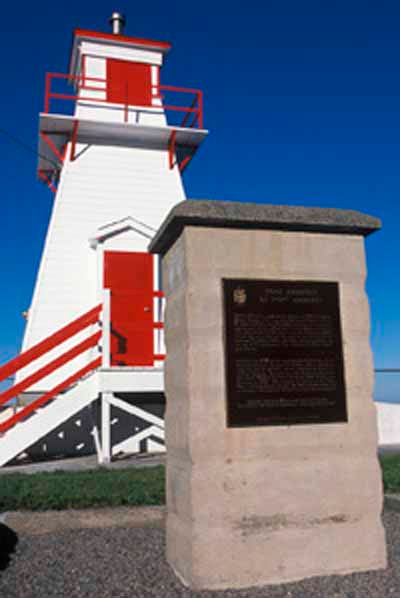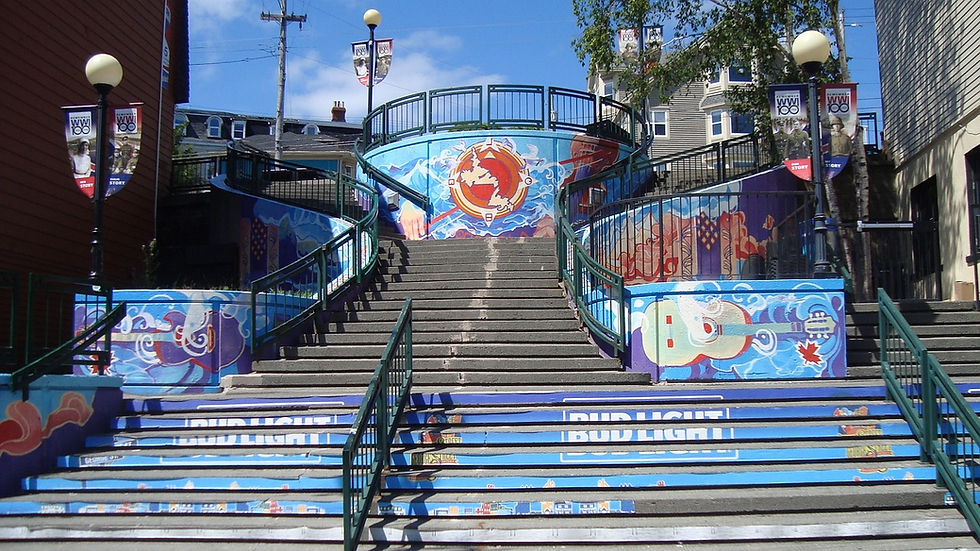Things to do in St. John's, Newfoundland
- Lyn (aka Jazz)

- Mar 4, 2024
- 6 min read
St. John's Newfoundland will charm visitors with colourful rowhouses and shops with whimsical names and signs. National Historic Sites, lighthouses, coastal trails, bustling nightlife, wildlife and brewery tours offer plenty of activities, but the unique local culture ensures every visitor a thoroughly delightful visit. This post includes a list of things to do in St. John's, Newfoundland, to enjoy a complete experience, including excursions, wanderings, and "havin' a time."

Table of Contents
Discovering St. John's: A Bit of Background
Exploring St. John's Newfoundland: Things to Do
Historic Landmarks and Natural Wonders
Signal Hill National Historic Site
Cape Spear National Historic Site
Fort Amherst National Historic Site
Unique Experiences and Activities
Discovering St. John's: A Bit of Background
St. John's was named in honour of the 15th-century explorer John Cabot, thought to be the first European to "discover" Newfoundland. Archeological evidence has since proved that Vikings had settlements 500 years earlier.
St. John's is built on high hills surrounding a landlocked harbour linked by a canal to fishing grounds that once teemed with cod, attracting the attention of Western European nations. Seasonal fishing outposts for the Portuguese, Spanish, French, and English soon dotted the coast. Small settlements endured multiple attacks from competing European countries for a couple hundred years. By the 1800s, St. John's had become a permanent British settlement.

During the late 1800s, Newfoundland thrived and enjoyed close economic ties with Britain. The colony declined an invitation to join other British North American colonies to form the Dominion of Canada. Economic conditions were very different after two world wars, the Great Depression, and fish stock reduction due to massive overfishing. A political crisis resulting in the imposition of British rule made joining Canada a more appealing option. Following a referendum in 1949, Newfoundland became Canada's tenth province.

The collapse of the cod fishery in the 1990s created widespread economic hardship. More than 30,000 workers were suddenly unemployed. Approximately 10% of the population moved to other provinces and countries in search of work. Government grants, private entrepreneurial efforts, and community programs were created to promote a more diverse economy. Modern St. John's is an economically diverse city with a distinct identity and culture.
Exploring St. John's Newfoundland: Top Things to Do
Historic Landmarks and Natural Wonders
Signal Hill National Historic Site defended the city from the 17th Century to WWII. It is also where Guglielmo Marconi received the world's first transatlantic wireless signal in 1901.

Explore military and communications history in the Cabot Tower museum. Plan to visit at midday for the firing of the Noon Day Gun. Take a windy trail walk along portions of the East Coast Trail. View Fort Amherst across the harbour.

Cape Spear Lighthouse National Historic Site: The Cape Spear Lighthouse, constructed in 1836, is the oldest surviving lighthouse in the province. Take a tour with one of the enthusiastic guides who tell tales of former light keepers and their isolated lives.

Pay attention to any safety warnings. Large rogue waves have swept away several visitors.
Fort Amherst National Historic Site: Across the harbour from Cape Spear, Fort Amherst was also crucial in defending the city. During both World Wars, fortifications were added to protect against enemy attacks. Enjoy a walk along the coastal path to the historic red and white lighthouse.

East Coast Trail: Join the East Coast Trail at Signal Hill for more than 300 kilometres of coastal trails and community paths. The trail includes challenging treks (Spout Path) and leisurely strolls (Sugarloaf Path). Delights along the route include hidden coves, rugged sea cliffs, and secluded beaches.

Unique Experiences and Activities
Puffin/Whale Watching: My favourite activity was joining a Puffin and Whale Watching Tour with O'Brien's Boat Tours. Passengers were treated to a lively narration from a guide as we saw Minke whales before moving on to the puffin nesting cliffs. We ended the tour with a Screech In Ceremony. Boat tours typically run from May to September.

Iceberg Alley: Visitors arriving in late May/early June will be thrilled by the sight of giant icebergs drifting past Newfoundland's coast. Refer to IcebergFinder.com for alerts.

Quidi Vidi Village: The charming fishing village of Quidi Vidi is a must-see waterfront neighbourhood with quaint streets lined with colourful cottages. Visit the Quidi Vidi Plantation to learn about traditional crafts. Sample local craft brews at the Quidi Vidi Brewery and take in spectacular views along the Quidi Vidi Lake Trail.

George Street: George Street is where the locals gather for food, nightlife and excitement. Don't expect any shops -- the two entire blocks are dedicated to restaurants, bars, and pubs. Look for local brews and live music.

Railway Coastal Museum: Train fans will want to visit the Railway Coastal Museum at St. Johbn's railway station. Interactive exhibits include vintage trains, photographs, and stories of travellers and workers.

The Rooms (Provincial Art Gallery, Museum, and Archives): The Rooms is a stunning cultural space with an art gallery, museum, and archives. Visitors can spend hours exploring exhibits highlighting indigenous traditions, contemporary art, maritime history, and fascinating archival treasures.

Jelly Bean Row: Most visitors will be struck by the bright paint colours used on row homes in the city. The origin of "Jelly Bean Row" is unclear, but it aptly captures these buildings' eye-catching and playful nature. Jellybean Row isn't a single street and can be found all over the city. Shops in these buildings advertise using whimsical fonts on signs.

It is often believed that the paint colours were chosen to be seen through the fog by returning fishermen. Still, the reality is that the repainting was a local strategy developed during the 1970s to revitalize the downtown core. The programme was embraced by locals and spread far beyond the original downtown area.
Cultural Immersion and Adventures
Brewery Tour: Passionate fans of craft brews will find themselves thrilled with choices from traditional to innovative brews. Brewery tours take visitors through the brewing process and include tastings. A popular option is to join the Brew Bus Tour to freely taste without worrying about driving.

Get Screeched: Screech is the local (and very potent) rum. Getting "Screeched-In" is an absurd ceremony for visitors to earn honourary "Newfie" status. The ceremony requires those who "come from away" to recite a Newfoundland oath, kiss a codfish, and seal the ritual with a shot of Screech. Join in the fun at local pubs and establishments offering Screech-ins. Many tours include the experience. Expect the locals to join in the fun as they welcome visitors with open arms and plenty of laughter and teasing. It's an experience you won't soon forget.

Play the Ugly Stick: The Ugly Stick is a traditional Newfoundland musical instrument made from household items like broomsticks, bottlecaps, tin cans and cutlery. You can buy a Ugly Stick online from a local boutique shop, but the best Ugly Sticks are home-made. Look for workshops where you can make your personal Ugly Stick and join others in a jam session of traditional folk songs. Have Fun with the Local Slang: Those who live "on the Rock" have a distinctive accent and style of unique slang that leave some "come-from-away (CFA)" quite perplexed. Take some time to google Newfoundland slang and 'fore long ye'll 'ave 'er scald, b'y.
Essential Tips for Travelers
Best Time to Visit St. John's: The best time to visit depends on your preferences. Winter can be harsh, with fewer open attractions and reduced operating hours. Fall offers stunning foliage and the famous Mummers Festival in late November. Late Spring is perfect for those wanting to see action along Iceberg Alley. Summer's mild temperatures and long days are comfortable for outdoor activities and local attractions.

Getting Around/Transportation: St. John's is easy to navigate without a vehicle. There are a lot of hills, but the downtown area is relatively small, so walking or renting a bicycle is an option. Buses, taxis, and ride-sharing are efficient and reasonably priced.

Time Needed: Plan to spend at least three to five days in the city. The journey to Newfoundland and St. John's is long, and the province is vast. I recommend a minimum of two weeks to explore the province. Have flexible departure dates, as storms can delay ferry sailings. My return voyage in early September was delayed almost 48 hours.
Final Thoughts
St. John's, Newfoundland, is a modern city with a unique identity, vibrant culture, stunning landscapes, a rich history and warm, welcoming people, deserving a place on your Canadian itinerary.
If you enjoy the content and want to be updated with new posts, become a member/subscriber (it's free!) and follow along on the RamblynJazz Facebook page, Facebook Group, Twitter, and Instagram. You can help the blog to grow by sharing the link with a travelling friend or through social media. I truly appreciate your comments and encourage you to share your thoughts below.







Anything that includes puffins and icebergs has my attention :)
St. John's and its colorful houses would certainly delight me as I wandered the streets. The landscapes are absolutely fabulous and complement the scenery of a city with so much charisma.
Canada is undoubtedly an endless source of fabulous places to explore and St. John's is no exception. Angela | Blonde Around The World Travel -
Thanks for sharing more information on yet another wonderful part of Canada. The hiking opportunities and being surrounded by interesting nature that can keep you engaged for hours including the iceberg watching is something I would love to do. The colourful houses add a much needed fun aspect to the dreary early spring weather. I thought about 1 to 2 days and then was surprised at your suggestion of two full weeks. I don't know if I can hang around for that long but I take it this is just the right amount of time for any destination to get a good grasp and understanding of it.
Carolin | <a href="https://solotravelstory.com/">Solo Travel Story</a>
Wow, St. Johns seems like a fascinating destination with a rich history and plenty of unique experiences to offer. The combination of historic landmarks, natural wonders, and cultural immersion activities surprised me. I look forward to exploring the vibrant city, trying out the local brews, and maybe even getting "Screeched-In" for an unforgettable experience. I definitely would love to see a puffin too!
Thanks for sharing a lovely introduction to this vibrant and laid-back city. Sights run aplenty as well things to do. Puffin and whale watching, to me is a very Newfoundland experience. I don't think I'll be ready to kiss a cod and no screech-ins for me either but happy to imbibe a drink anytime where they brew the best Dildos! lol ;-) #flyingbaguette
Jan - https://flyingbaguette.com/
St John's, and Newfoundland in general, is a place I'd really love to visit. My friend is from there and I'm interested in checking it out - if only it didn't feel so far away from us on the west coast. It's cool to see there's a lot of history though, more than in BC obviously. The trails look like something I'd like to explore, and seeing an iceberg, or some puffins. I'm going to have to make an effort to head over very far east very soon